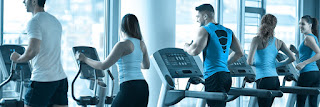Sunday, December 3, 2017
How to minimise post-exercise aches and pains
Taipei Gym, Anyone who has ever set foot in a gym or spent a day lifting boxes in a house move has suffered from them - post-exercise aches and pains. When you forget you have done anything strenuous until you try to get out of bed, and when getting up to go to the toilet is a struggle, you know you have overdone it.
With summer just around the corner, you may be doubling your efforts at the gym and putting maximum effort into your pre-beach fitness plans, rendering yourself useless the following day. For those struggling more than usual, help is at hand. At the boutique gym The Foundry in Old Street, a team of experts help you recover quickly and effectively from muscle aches and joint problems. Therapist Peter Dipple has worked extensively with Olympic athletes from a variety of sports and is the go-to person for bespoke sports massage; or book to see osteopath Chris Eke who can magically identify the cause of niggling back problems and treat them in a flash; while physiotherapist Andy Ireland can asses your posture and offer tons of helpful advice to help you stay pain-free, fit and healthy.
For those with milder, yet still annoying symptoms of DOMS, read on to learn more about its causes, its treatments, and if and when it should ever be cause for concern. The founder of Holland Park's Equilibrium gym, Niko Algieri, explains all...
What is DOMS?
"Delayed onset of muscle soreness is what causes the statement 'I literally cannot walk today!' In technical terminology the soreness is felt most strongly 24 to 72 hours after exercise. It is thought to be caused by eccentric (lengthening) exercise, which causes small-scale damage, or little tears to the muscle fibres. After such exercise, the muscle adapts rapidly to prevent muscle damage, and thereby soreness, if the exercise is repeated. The cause actually comes from the lowering phase of a contraction. So for example, lowering a weight in a bicep curl or the lengthening of the quad in a squat."
Why do we get it sometimes and not others?
"A few reasons. Your muscles have healed, and adapted to become stronger. If you lift the same weights at the same rep range and the same range of movement, there is no adaptation to be made so you'll feel normal. Increase the weight and see what happens!"
Is it ever a cause for concern?
"Not really. If you're a beginner and you overdo your first session, you'll more than likely be rendered immobile for about five days. Apart from developing a Netflix obsession you'll be fine eventually. What you do want to worry about is Rhabdomyolysis, which is the breaking down of muscle fibre - but you have to go crazy with heavy weights for a sustained period to get this."
Is the adage 'pain is beauty' true - are you doing your workout wrong if you don't feel a little soreness the day after?
"You don't have to feel soreness every time, be cool, sometimes you can train active recovery from yesterday's session; other days you can maintain or do cardio. It's crazy to cause that amount of damage in every session. Also, psychologically you'll always be down from what appears to be a lack of improvement. If you're fit, you have more muscle fibres and stronger muscle. You'll take the strain more than a person who seems to have never activated any their muscle groups. Remember your very first weights session? I do. It felt like a bus had a ran over me, twice!"
Is there anything you can do to help ease discomfort?
"My advice is to just go with it. You can stretch, have an Epsom salts bath and various other remedies but in the end you're just waiting for your muscles to heal. Eat good quality lean protein, drink fluids and relax. Never forget the importance of a rest day for muscle recovery and performance."
References: Taipei Gym, Taipei Fitness, Core Space
Subscribe to:
Post Comments (Atom)


No comments:
Post a Comment
Thank you has been commented